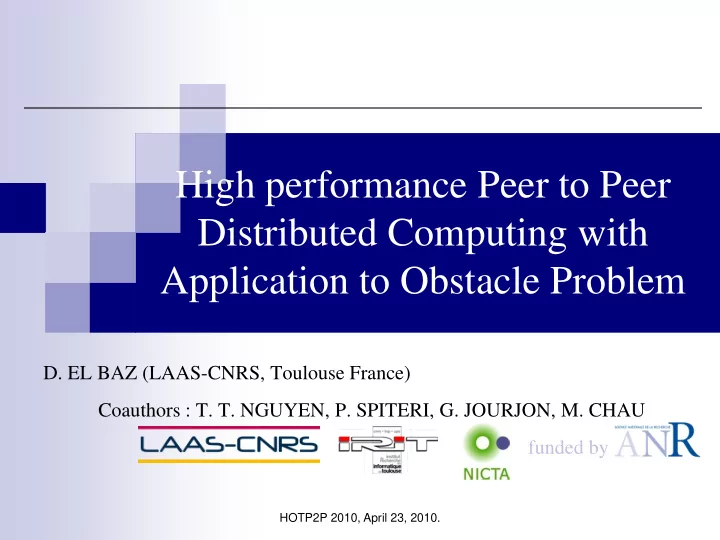

High performance Peer to Peer Distributed Computing with Application to Obstacle Problem D. EL BAZ (LAAS-CNRS, Toulouse France) Coauthors : T. T. NGUYEN, P. SPITERI, G. JOURJON, M. CHAU funded by HOTP2P 2010, April 23, 2010.
Outline 1 Goal tt 2 Self-adaptive protocol 3 Environment 4 Experiments 5 Conclusions HOTP2P 2010, April 23, 2010. 2
1. Goal Great development of peer to peer applications File sharing, video, ... Recent advances in microprocessor architecture and high bandwith network → new applications like distributed HPC computing/computing on the Internet. Great challenges Scalability, Heterogeneity, Volatility, Existing protocols, TCP, UDP not well suited to HPC. 1 2 3 4 5 5 Goal Protocol Environment Experiments Conclusions HOTP2P 2010, April 23, 2010. 3
1. Goal (cont’d) High performance peer to peer computing: Task parallel model, distributed iterative methods. Direct communications between peers. Applications: numerical simulation & optimization. Self-adaptive protocol: based on Cactus framework uses micro-protocols chooses dynamicaly the most appropriate communica- tion mode in function of elements of context from network level and choices at application level. 1 2 3 4 5 5 Goal Protocol Environment Experiments Conclusions HOTP2P 2010, April 23, 2010. 4
2. Self-adaptive protocol Micro-protocols Introduced in x-kernel Approach to design self-adaptive communication protocols Micro-protocols implement a functionnality (sample) Communication: Synchronous, Asynchronous. Fragmentation: FixeSize, Resize. Reliability: Retransmission, PositiveAck, NegativeAck, DuplicateAck. Order : LossyFifo, ReliableFifo. Congestion control: NewReno TCP Congestion Control. Composition of micro-protocols → protocol Reuse code, facilitate design, configure dynamically. 1 2 3 4 5 5 Goal Protocol Environment Experiments Conclusions HOTP2P 2010, April 23, 2010. 5
2. Self-adaptive protocol (cont’d) Protocol composition framework → deployment of architecture Hierarchical model (stack of protocols), x-kernel, APPIA frameworks. Nonhierarchical model (no order), Coyote and ADAPTIVE frame’ks. Hybrid model (combo), XQoS and Cactus frameworks → CTP. Cactus framework flexible, efficient. Two grain levels: Composite protocols : individual protocol made of micro-protocols. Protocol stack : composite protocols layered on the top of each others. Protocols can reconfigure by substituting protocols or micro-protocols. 1 2 3 4 5 5 Goal Protocol Environment Experiments Conclusions HOTP2P 2010, April 23, 2010. 6
2. Self-adaptive protocol (cont’d) Cactus is an event based framework: Events: state changes, e.g. arrival of messages. Micro-protocols structured as a collection of event handlers: Event handler : procedure like segments of codes bound to events. When an event occurs all handlers bound to that event are executed. Our modifications to Cactus → improve protocol performance/facilitate reconfiguration: Concurrent handler execution (multicore machines). Eliminate unnecessary copies between layers (use pointers) Operation for micro-protocol removing. 1 2 3 4 5 5 Goal Protocol Environment Experiments Conclusions HOTP2P 2010, April 23, 2010. 7
2. Self-adaptive protocol (cont’d) P2PSAP protocol architecture API ~~~~~~~~~~~ Manages session Transfers data opening an closure between peers Captures context information Transport layer Reconfigures data channel/coordinates ~~~~~~~~~~~ peers Physical layer 1 2 3 4 5 5 Goal Protocol Environment Experiments Conclusions HOTP2P 2010, April 23, 2010. 8
2. Self-adaptive protocol (cont’d) Communication adaptation rules Scheme Synchronous Asynchronous Hybrid Link Synchronous Asynchronous Synchronous Intra-cluster Reliable Com. Reliable Com. Reliable Com. Synchronous Asynchronous Asynchronous Inter-cluster Reliable Com. Unreliable Com. Unreliable Com. 1 2 3 4 5 5 Goal Protocol Environment Experiments Conclusions HOTP2P 2010, April 23, 2010. 9
2. Self-adaptive protocol (cont’d) Reconfiguration mechanism 1 2 3 4 5 5 Goal Protocol Environment Experiments Conclusions HOTP2P 2010, April 23, 2010. 10
2. Self-adaptive protocol (cont’d) Example of scenario 1 2 3 4 5 5 Goal Protocol Environment Experiments Conclusions HOTP2P 2010, April 23, 2010. 11
3. Environment Direct communication between peers Reduced set of communication operations: - only send and receive operations (P2P_send and P2P_receive). - facilitate programming, hide complexity. Communication mode can vary with context: - programmer does not select directly a communication mode (programmer can select a scheme of computation). - communication mode depends on the context and is determined by the protocol. - good efficiency. 1 2 3 4 5 5 Goal Protocol Environment Experiments Conclusions HOTP2P 2010, April 23, 2010. 12
3. Environment (cont’d) P2PDC Environment architecture 1 2 3 4 5 5 Goal Protocol Environment Experiments Conclusions HOTP2P 2010, April 23, 2010. 13
3. Environment (cont’d) Application deployment 1 2 3 4 5 5 Goal Protocol Environment Experiments Conclusions HOTP2P 2010, April 23, 2010. 14
4. Experiments 3D Obstacle problem - numerical simulation problems (pde) - financial mathematics, e.g. option pricing - mechanics 1 2 3 4 5 5 Goal Protocol Environment Experiments Conclusions HOTP2P 2010, April 23, 2010. 15
4. Experiments (cont’d) Fixed point problem: Distributed asynchronous iterative scheme: 1 2 3 4 5 5 Goal Protocol Environment Experiments Conclusions HOTP2P 2010, April 23, 2010. 16 (5)
4. Experiments (cont’d) Results 3D obstacle problem, slice decomposition, 3,000,000 variables, NICTA testbed, Sidney. 1 2 3 4 5 5 Goal Protocol Environment Experiments Conclusions HOTP2P 2010, April 23, 2010. 17
5. Conclusions Self-adaptive protocol P2PSAP for P2P HPC Current version of environment P2Pdc Experiments on NICTA and Grid 5000 testbeds for obstacle problem. Decentralised functions of P2PDC. Improvements: code, protocol, environment. Applications: process engineering, logistics. Other testbeds PlanetLab (GENI). Self-organization → efficiency & everlastingness. 1 2 3 4 5 5 Goal Protocol Environment Experiments Conclusions HOTP2P 2010, April 23, 2010. 18
Recommend
More recommend